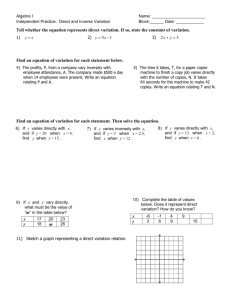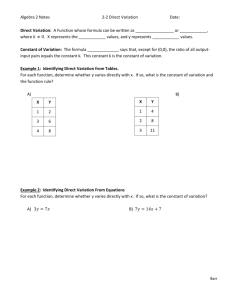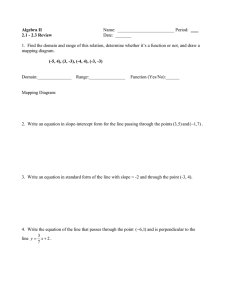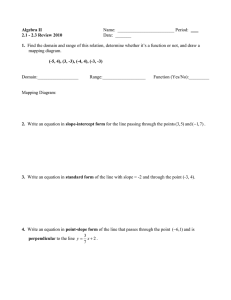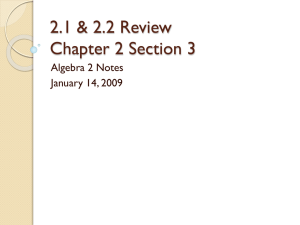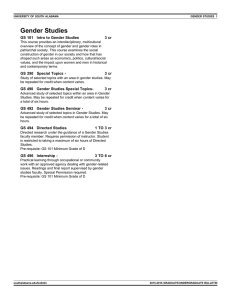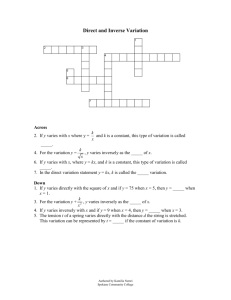Dissertation Workshop: Exercise 4 Solutions
advertisement
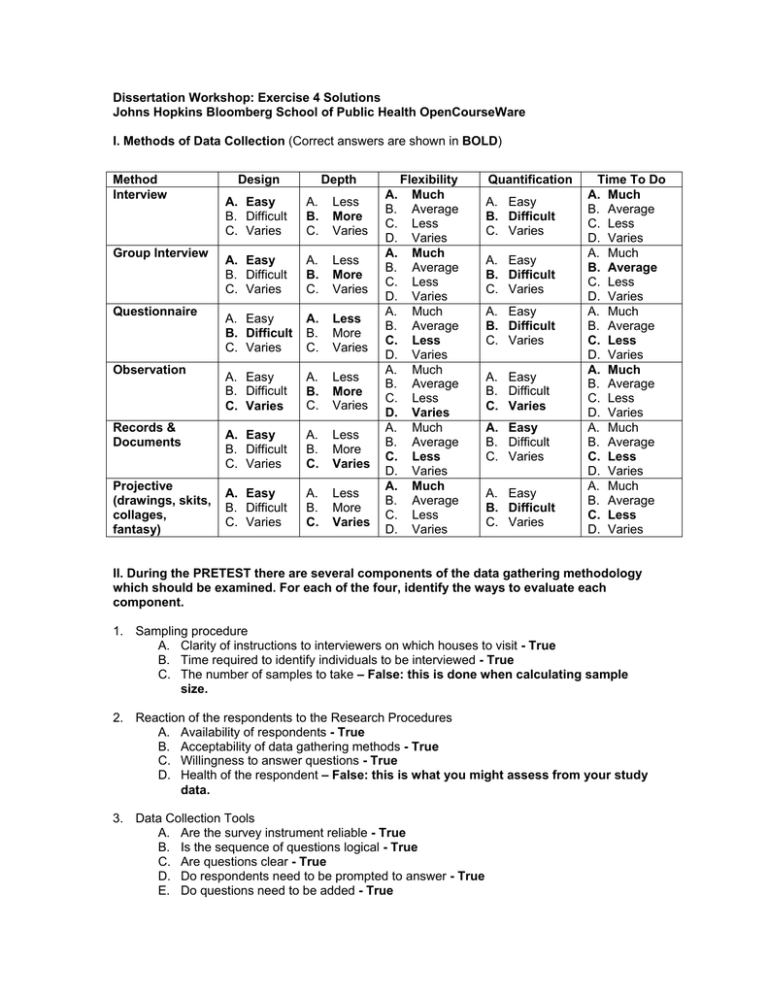
Dissertation Workshop: Exercise 4 Solutions Johns Hopkins Bloomberg School of Public Health OpenCourseWare I. Methods of Data Collection (Correct answers are shown in BOLD) Method Interview Group Interview Questionnaire Observation Records & Documents Projective (drawings, skits, collages, fantasy) Design Depth A. Easy B. Difficult C. Varies A. B. C. Less More Varies A. Easy B. Difficult C. Varies A. B. C. Less More Varies A. Easy B. Difficult C. Varies A. B. C. Less More Varies A. Easy B. Difficult C. Varies A. B. C. Less More Varies A. Easy B. Difficult C. Varies A. B. C. Less More Varies A. Easy B. Difficult C. Varies A. B. C. Less More Varies A. B. C. D. A. B. C. D. A. B. C. D. A. B. C. D. A. B. C. D. A. B. C. D. Flexibility Much Average Less Varies Much Average Less Varies Much Average Less Varies Much Average Less Varies Much Average Less Varies Much Average Less Varies Quantification A. Easy B. Difficult C. Varies A. Easy B. Difficult C. Varies A. Easy B. Difficult C. Varies A. Easy B. Difficult C. Varies A. Easy B. Difficult C. Varies A. Easy B. Difficult C. Varies Time To Do A. Much B. Average C. Less D. Varies A. Much B. Average C. Less D. Varies A. Much B. Average C. Less D. Varies A. Much B. Average C. Less D. Varies A. Much B. Average C. Less D. Varies A. Much B. Average C. Less D. Varies II. During the PRETEST there are several components of the data gathering methodology which should be examined. For each of the four, identify the ways to evaluate each component. 1. Sampling procedure A. Clarity of instructions to interviewers on which houses to visit - True B. Time required to identify individuals to be interviewed - True C. The number of samples to take – False: this is done when calculating sample size. 2. Reaction of the respondents to the Research Procedures A. Availability of respondents - True B. Acceptability of data gathering methods - True C. Willingness to answer questions - True D. Health of the respondent – False: this is what you might assess from your study data. 3. Data Collection Tools A. Are the survey instrument reliable - True B. Is the sequence of questions logical - True C. Are questions clear - True D. Do respondents need to be prompted to answer - True E. Do questions need to be added - True F. Is the translation accurate - True 4. Staffing and Field Work A. Have the interviewers been trained adequately - True B. Are the interviews proceeding on schedule - True C. Do staff have the supplies and transportation they need to get the job done - True D. Are the staff being non-judgmental and objective when interviewing respondents True E. Is supervision and quality control adequate - True F. Do the data confirm the hypothesis – False: this question is addressed during analysis. III. References Ainsworth, Martha. 1986. Implementing of the LSS in the Field. Washington, DC: World Bank. Arnold F. 1990. An Assessment of the Quality of Birth History Data in the DHS Surveys. Pages 83-109 in Methodological Report #1: An Assessment of DHS-1 Data Quality. Calverton, MD: DHS Institute for Resource Development/Macro Systems, Inc. Atkin L. 1989. Psycho-Social Aspects of Data Collection. Pages 81-84 in Methodological Issues in Abortio Research, F. Coeytaux, et al (eds). Proceedings of a seminar presented under the Population Council's Robert H. Ebert Program on Critical Issues in Reproductive Health in collaboration with International Projects Assistance Services and the World Health Organization, December 12-13. New York: The Population Council. Aziz KMA, Mosley WH. Historical Perspective and Methodology of the Matlab Project. In V Vauveau (ed) Matlab Women, Children, and Health. Bangladesh: ICDDR,B Special Publication No. 35, 1994. Becker, S, Mahamud S. 1984. A Validation Study of Backward and forward Pregnancy Histories in Matlab, Bangladesh. World Fertility Surveys Scientific Report #52. Voorburg, Netherlands: International Statistical Institute. Boerma JT (ed). 1992. Measurement of Maternal and Child Mortality and Morbidity and Health Care. Liege, Belgium: IUSSP, pp. 225-259. De Silva WI. 1992. Response Reliability of Demographic Data: A Longitudinal Study in Sri Lanka. Journal of Biosocial Science 24: 77-88. Goldman N, Moreno L. Westoff C. 1989. Peru Experimental Survey: An Evaluation of Fertility and Child Health Information. Princeton, NJ: Office of Population Research of Princeton University, and Calverton, MD: DHS Institute for Resource Development/Macro Systems, Inc. Grootaert, Christiaan. 1986. Measuring and Analyzing Levels of Living in Developing Countries: An Annotated Questionnaire. Living Standards Measurement Study Working Paper No. 24. Washington, DC: The World Bank. Grosh MD, Glewwe. 1995. A Guide to Living Standards Measurement Study Surveys and Their Data Sets. LSMS Working Paper Number 120. Washington, DC: The World Bank. Jemai H, Singh S. 1987. Questionnair design dor demographic events. Pages 129-147 in World Fertility Survey, An Assesment, J. Cleland and C. Scott (eds). Oxford University Press. Langsten R, Hill K. Diarrheal disease, oral rehydration and childhood ortality in rural Egypt. Journal of Tropical Pediatrics 40, 1995. Osinski P. 1991. Child Characteristics, Diarrheal Episode Characteristics, and Mothers' Interpretations of Diarrheal Episodes as Determinants of the Use of Oral Rehydration Therapy in Rural and Urban Bangladesh. DrPH thesis, Department of International health, The Johns Hopkins University School of Hygiene and Public Health, Baltimore, MD.
